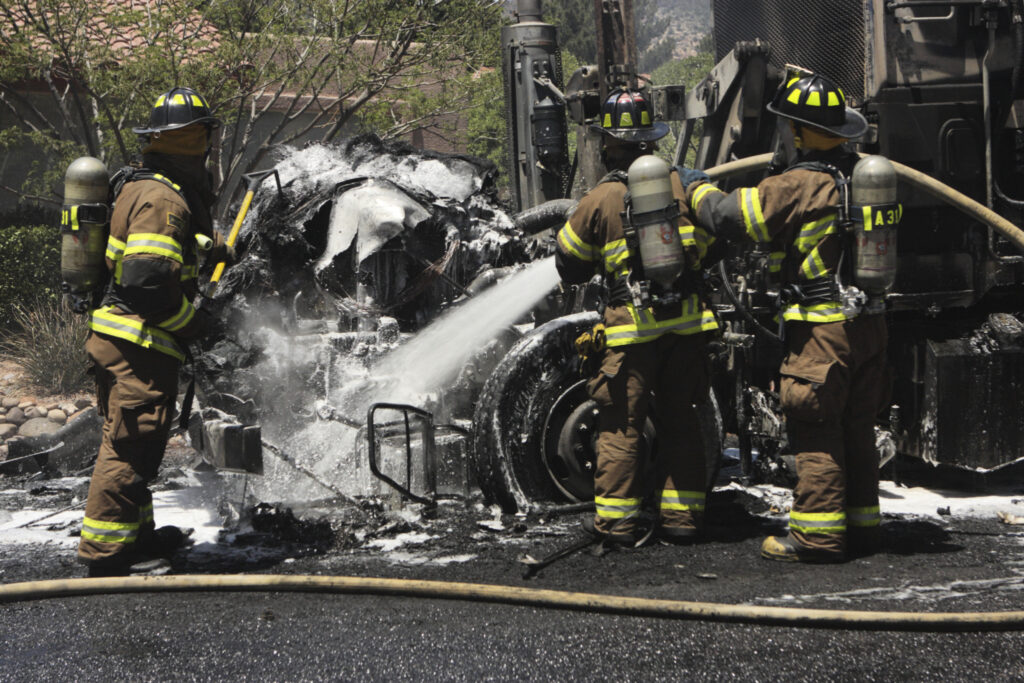10 tips for fighting and preventing truck fires
The only combustion welcome on a truck would be within the confines of an engine cylinder. But truck fires continue to be a common occurrence — and not just in the wake of collisions.
Division Chief Phil Bott of the Fire and Emergency Services Training Institute (FESTI), a private career college that serves corporate and emergency services personnel, offers several tips for preventing and fighting such fires.

1. Begin with a focus on prevention
When it comes to tackling fires, the best offence is a good defence. In other words, identify some of the issues that can trigger flames in the first place.
Dragging brakes – caused by factors as diverse as driving with parking brakes applied, failed brake chamber diaphragms, or corroded disc brake calipers – will lock wheel ends in place. This friction leads to the heat that ignites wheel fires. Blown turbos lead to challenges as well. A manual regen for a diesel particulate filter (DPF), meanwhile, can generate the heats that will ignite a surrounding field if the truck is parked in tall grass.
These dangers and more can be limited through preventive maintenance programs, ongoing inspections, and even safer parking choices.
2. Know and inspect your cargo
Fuel tankers are clearly marked with Transportation of Dangerous Goods (TDG) placards where appropriate. But this is not the only cargo that can catch fire. Damaged and leaking containers can release vapors that will quickly combine with an ignition source.
“When we have appropriate shipping documents that are labeled, then we’re well informed,” Bott says, referring to a key preventive measure. Ensure the loads are properly secured, too.

3. Pay attention to the ABCs when choosing extinguishers
Few tools are more effective than a fire extinguisher when it comes to bringing a truck fire under control.
There are five classes of fires and multiple extinguishing agents, Bott says. A multi-purpose dry chemical extinguisher will be the best fit for Class A, B and C fires that are most likely to occur in trucking.
These will be appropriate for regular combustibles that turn to Ash (A), material like fuel that can be carried in Barrels (B), or items charged with electric Current (C). So if a driver comes across downed power lines near a pool of diesel, they would have the tools for the job.
4. Monitor the extinguisher pressure
Correctly pressurized fire extinguishers will show a needle sitting clearly in the green range.
“They have gotten a lot better with remaining pressurized,” Bott says. “It will generally hold its pressure until its next major inspection – upward of five years.”
5. Keep the fire extinguishers in easy reach
A fire extinguisher can only do its job if a driver can place their hands on it.
“That safety equipment is your insurance policy,” Bott says. Ensure it’s not hidden away under a pile of clothes in the sleeper.
6. Tackle the flames in the early stages
Fire extinguishers are largely meant to buy some time until emergency services personnel arrive on scene, or knock down the flames as trapped people are freed from wreckage.
“If the fire is rapidly spreading, don’t try to combat it, because there’s some kind of factor spreading it,” Bott says.
7. Take a PASS when fighting the fire
Bott reminds people to remember the “PASS” acronym when using a fire extinguisher. Pull the pin. Aim the stream at the base of the fire. Squeeze the trigger. Sweep from side to side.
It’s also a good idea to quickly test the extinguisher before getting too close. Many dry chemical extinguishers will only spread their contents over two to three meters, he says. “You’re going to have to be fairly close to the fire.”
“Get to the upwind side of the fire so the wind can carry the dry chemicals to the seat of the fire,” he adds.
8. Remember that the danger remains
Any fire relies on a fuel source, oxygen, and heat. While a fire extinguisher can inhibit the fire’s chemical reaction, the three underlying issues remain.
Consider a truck that comes in hard, jams on the brakes, and slams into another vehicle. The hot brakes can combine with leaking fuel and ignite. The fire extinguisher will knock down the flames, but the hot brakes can still reignite the fuel.
Even if things look under control, continue to monitor the situation.
9. Offer emergency teams as much detail as possible
Emergency responders are going to be in the best position to help if they know the type of dangers that exist. That means reporting information about any placards on the loads.
“Having that early identification of the situation involving hazmat is key for us as emergency responders,” Bott says. A traffic collision might comfortably be handled by a pair of fire trucks. If that same fire involves an MC 406 tanker filled with fuel, it’s an entirely different response.
10. Know your personal limits
Everyone will approach a fire with a different level of experience. Some drivers may have used extinguishers on multiple occasions, while their peers may be facing flames for the first time.
“We tell students to use [the fire extinguisher] as long as you’re comfortable with it,” Bott says.
That level of comfort can increase with some hands-on training. FESTI and local fire departments alike offer training opportunities that show employees what a fire extinguisher will feel like, before it actually has to be put to work.
Have your say
This is a moderated forum. Comments will no longer be published unless they are accompanied by a first and last name and a verifiable email address. (Today's Trucking will not publish or share the email address.) Profane language and content deemed to be libelous, racist, or threatening in nature will not be published under any circumstances.